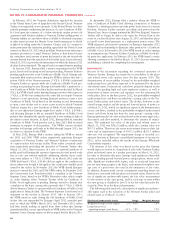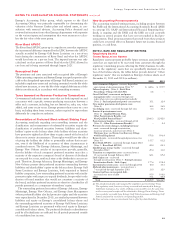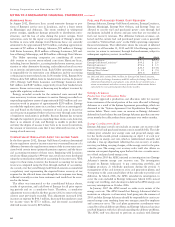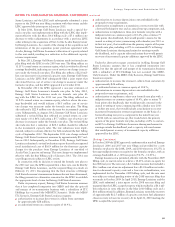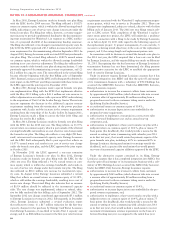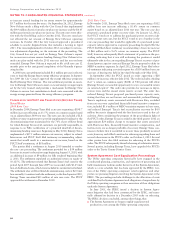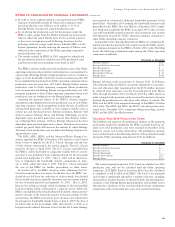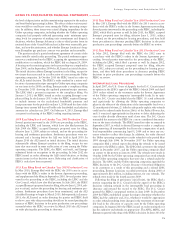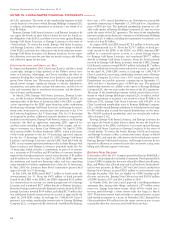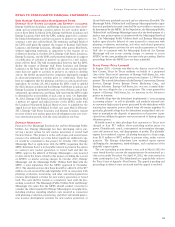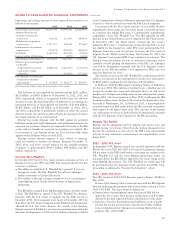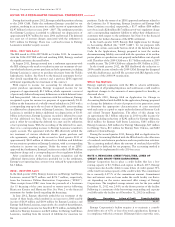Entergy 2012 Annual Report Download - page 70
Download and view the complete annual report
Please find page 70 of the 2012 Entergy annual report below. You can navigate through the pages in the report by either clicking on the pages listed below, or by using the keyword search tool below to find specific information within the annual report.Entergy Corporation and Subsidiaries 2012
NOTES TO CONSOLIDATED FINANCIAL STATEMENTS continued
to increase annual funding for its storm reserve by approximately
$5.7 million for the next five years. On September 26, 2012, Entergy
New Orleans made a filing with the City Council that implemented
the $4.9 million electric formula rate plan rate increase and the $0.05
million gas formula rate plan rate increase. The new rates were effec-
tive with the first billing cycle in October 2012. The new rates have
not affected the net amount of Entergy New Orleans’s operating
revenues. In October 2012 the City Council approved a procedural
schedule to resolve disputed items that includes a hearing in April
2013. The rates implemented in October 2012 are subject to retroac-
tive adjustments depending on the outcome of the proceeding. The
City Council has not yet acted on Entergy New Orleans’s request
for an increase in storm reserve funding. Entergy New Orleans’s for-
mula rate plan ended with the 2011 test year and has not yet been
extended. Entergy New Orleans is expected to file a full rate case 12
months prior to the anticipated completion of the Ninemile 6 gener-
ating facility.
A 2008 rate case settlement included $3.1 million per year in electric
rates to fund the Energy Smart energy efficiency programs. In Septem-
ber 2009 the City Council approved the energy efficiency programs
filed by Entergy New Orleans. The rate settlement provides an incen-
tive for Entergy New Orleans to meet or exceed energy savings targets
set by the City Council and provides a mechanism for Entergy New
Orleans to recover lost contribution to fixed costs associated with the
energy savings generated from the energy efficiency programs.
FILINGS WITH THE PUCT AND TEXAS CITIES (ENTERGY TEXAS)
Retail Rates
2009 Rate Case
In December 2009, Entergy Texas filed a rate case requesting a $198.7
million increase reflecting an 11.5% return on common equity based
on an adjusted June 2009 test year. The rate case also included a $2.8
million revenue requirement to provide supplemental funding for the
decommissioning trust maintained for the 70% share of River Bend
for which Entergy Texas retail customers are partially responsible, in
response to an NRC notification of a projected shortfall of decom-
missioning funding assurance. Beginning in May 2010, Entergy Texas
implemented a $17.5 million interim rate increase, subject to refund.
Intervenors and PUCT Staff filed testimony recommending adjust-
ments that would result in a maximum rate increase, based on the
PUCT Staff’s testimony, of $58 million.
The parties filed a settlement in August 2010 intended to resolve
the rate case proceeding. The settlement provided for a $59 million
base rate increase for electricity usage beginning August 15, 2010, with
an additional increase of $9 million for bills rendered beginning May
2, 2011. The settlement stipulated an authorized return on equity of
10.125%. The settlement stated that Entergy Texas’s fuel costs for the
period April 2007 through June 2009 are reconciled, with $3.25 mil-
lion of disallowed costs, which were included in an interim fuel refund.
The settlement also set River Bend decommissioning costs at $2.0 mil-
lion annually. Consistent with the settlement, in the third quarter 2010,
Entergy Texas amortized $11 million of rate case costs. The PUCT
approved the settlement in December 2010.
2011 Rate Case
In November 2011, Entergy Texas filed a rate case requesting a $112
million base rate increase reflecting a 10.6% return on common
equity based on an adjusted June 2011 test year. The rate case also
proposed a purchased power recovery rider. On January 12, 2012,
the PUCT voted not to address the purchased power recovery rider
in the current rate case, but the PUCT voted to set a baseline in the
rate case proceeding that would be applicable if a purchased power
capacity rider is approved in a separate proceeding. In April 2012 the
PUCT Staff filed direct testimony recommending a base rate increase
of $66 million and a 9.6% return on common equity. The PUCT
Staff, however, subsequently filed a statement of position in the pro-
ceeding indicating that it was still evaluating the position it would
ultimately take in the case regarding Entergy Texas’s recovery of pur-
chased power capacity costs and Entergy Texas’s proposal to defer its
MISO transition expenses. In April 2012, Entergy Texas filed rebut-
tal testimony indicating a revised request for a $105 million base rate
increase. A hearing was held in late-April through early-May 2012.
In September 2012 the PUCT issued an order approving a $28
million rate increase, effective July 2012. The order includes a finding
that “a return on common equity (ROE) of 9.80 percent will allow
[Entergy Texas] a reasonable opportunity to earn a reasonable return
on invested capital.” The order also provides for increases in depre-
ciation rates and the annual storm reserve accrual. The order also
reduced Entergy Texas’s proposed purchased power capacity costs,
stating that they are not known and measureable; reduced Entergy
Texas’s regulatory assets associated with Hurricane Rita; excluded
from rate recovery capitalized financially-based incentive compensa-
tion; included $1.6 million of MISO transition expense in base rates,
and reduced Entergy’s Texas’s fuel reconciliation recovery by $4.0
million because it disagreed with the line-loss factor used in the cal-
culation. After considering the progress of the proceeding in light of
the PUCT order, Entergy Texas recorded in the third quarter 2012 an
approximate $24 million charge to recognize that assets associated
with Hurricane Rita, financially-based incentive compensation, and
fuel recovery are no longer probable of recovery. Entergy Texas con-
tinues to believe that it is entitled to recover these prudently incurred
costs, however, and it filed a motion for rehearing regarding these and
several other issues in the PUCT’s order on October 4, 2012. Several
other parties have also filed motions for rehearing of the PUCT’s
order. The PUCT subsequently denied rehearing of substantive issues.
Several parties, including Entergy Texas, have appealed the PUCT’s
order to the Travis County District Court.
System Agreement Cost Equalization Proceedings
The Utility operating companies historically have engaged in the
coordinated planning, construction, and operation of generating and
bulk transmission facilities under the terms of the System Agreement,
which is a rate schedule that has been approved by the FERC. Cer-
tain of the Utility operating companies’ retail regulators and other
parties are pursuing litigation involving the System Agreement at the
FERC. The proceedings include challenges to the allocation of costs
as defined by the System Agreement and allegations of imprudence by
the Utility operating companies in their execution of their obligations
under the System Agreement.
In June 2005, the FERC issued a decision in System Agree-
ment litigation that had been commenced by the LPSC, and essen-
tially affirmed its decision in a December 2005 order on rehearing.
The FERC decision concluded, among other things, that:
n The System Agreement no longer roughly equalizes total
production costs among the Utility operating companies.
68




